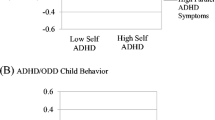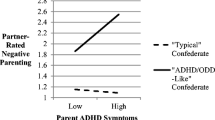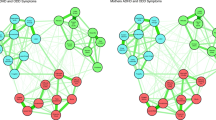Abstract
The sequential interactions of three groups of teenagers conversing with their mothers during both neutral and conflict discussion situations were evaluated. Groups consisted of (1) attention deficit hyperactivity disorder (ADHD) alone (n =21), (2) ADHD with comorbid oppositional defiant disorder (ADHD/ODD; n =40), and (3) a community control group of adolescents (n =49). All groups had been followed concurrently for the past 8 to 10 years before being reevaluated in this study. Results indicated that (1) teens and parents in all groups interacted in a tightly linked manner, with the behavior of each member being significantly related only to the immediate antecedent behavior of the other; (2) mothers in all groups were more likely than teens to initiate positive behaviors; (3) teen interactions could be characterized as tit-for-tat while mothers could be typified as be-nice-and-forgive; (4) mother-teen dyads in the ADHD/ODD group displayed significantly higher rates of conflict behaviors than dyads in the other two groups, who did not differ significantly from each other on most measures; and (5) mothers in the ADHD/ODD group responded in a manner similar to their teens (greater negativity) and less like that of mothers in the other groups. The majority of conflict between ADHD children and their parents seemed due to comorbid ODD and such ODD is a family, not just a teen, characteristic.
Similar content being viewed by others
References
American Psychiatric Association. (1987).Diagnostic and statistical manual of mental disorders (3rd ed., rev.). Washington, DC: Author.
Anderson, T. W., & Goodman, L. A. (1957). Statistical inference about Markov chains.Annals of Mathematical Statistics, 28, 89–110.
Arundale, R. B. (1982).User's guide to SAMPLE and TEST: Two Fortran IV computer programs for the analysis of discrete state time-varying data, using Markov chain techniques. Fairbanks: Department of Speech and Drama, University of Alaska.
Axelrod, R. (1984).The evolution of cooperation. New York: Basic Books.
Barkley, R. A. (1981).Hyperactive children. New York: Guilford Press.
Barkley, R. A. (1985). The social interactions of hyperactive children: Developmental changes, drug effects, and situational variation. In R. McMahon & R. Peters (Eds.),Childhood disorders: Behavioral-developmental approaches (pp. 218–243). New York: Bruner/Mazel.
Barkley, R. A. (1990).Attention deficit hyperactivity disorder: A handbook for diagnosis and treatment. New York: Guilford Press.
Barkley, R. A., Anastopoulos, A. D., Guevremont, D. G., & Fletcher, K. F. (1992). Adolescents with attention deficit hyperactivity disorder: Mother-adolescent interactions, family beliefs and conflicts, and maternal psychopathology.Journal of Abnormal Child Psychology, 20, 263–288.
Barkley, R. A., Fischer, M., Edelbrock, C. S., & Smallish, L. (1990). The adolescent outcome of hyperactive children diagnosed by research criteria, I: An 8 year prospective follow-up study.Journal of the American Academy of Child and Adolescent Psychiatry, 29, 546–557.
Barkley, R. A., Fischer, M., Edelbrock, C. S., & Smallish, L. (1991). The adolescent outcome of hyperactive children diagnosed by research criteria, III: Mother-child interactions, family conflicts, and maternal psychopathology.Journal of Child Psychology and Psychiatry, 32, 233–256.
Barkley, R. A., Karlsson, J., & Pollard, S. (1985). Effects of age on the mother-child interactions of ADD-H and normal boys.Journal of Abnormal Child Psychology, 13, 631–637.
Campbell, S. B. (1973). Mother-child interaction in reflective, impulsive, and hyperactive children.Developmental Psychology, 8, 341–349.
Campbell, S. B. (1975). Mother-child interaction: A comparison of hyperactive, learning disabled, and normal boys.American Journal of Orthopsychiatry, 45, 51–57.
Cunningham, C. E., & Barkley, R. A. (1979). The interactions of hyperactive and normal children with their mothers during free play and structured task.Child Development, 50, 217–224.
Danforth, J. S., Barkley, R. A., & Stokes, T. F. (1991). Observations of interactions between parents and their hyperactive children: An analysis of reciprocal influence.Clinical Psychology Review, 11, 703–727.
Dumas, J. E. (1986). Indirect influence of maternal social contacts on mother-child interactions: A setting event analysis.Journal of Abnormal Child Psychology, 14, 203–216.
Fienberg, S. E. (1980).The analysis of cross-classified categorical data (2nd ed.). Cambridge, MA: MIT Press.
Fischer, M., Barkley, R. A., Edelbrock, C. S., & Smallish, L. (1990). The adolescent outcome of hyperactive children diagnosed by research criteria, II: Academic, attentional, and neuropsychological status.Journal of Consulting and Clinical Psychology, 58, 580–588.
Fischer, M., Barkley, R. A., Fletcher, K., & Smallish, L. (1993). The stability of dimensions of behavior in ADHD and normal children over an 8 year period.Journal of Abnormal Child Psychology, 21, 315–337.
Gottman, J. M., & Roy, A. K. (1990).Sequential analysis: A Guide for behavioral researchers. New York: Cambridge University Press.
Hops, H., Biglan, A., Sherman, L., Arthur, J., Friedman, L., & Osteen, V. (1987). Home observations of family interactions of depressed women.Journal of Consulting and Clinical Psychology, 55, 341–346.
Lichtenberg, J. W., & Heck, E. J. (1986). Analysis of sequence and pattern in process research.Journal of Counseling Psychology, 33, 170–181.
Loeber, R. (1990). Development and risk factors of juvenile antisocial behavior and delinquency.Clinical Psychology Review, 10, 1–42.
Mash, E. J., & Johnston, C. (1982). A comparison of mother-child interactions of younger and older hyperactive and normal children.Child Development, 53, 1371–1381.
Norusis, M. J. (1990).SPSS/PC+, 4.0, Statistical data analysis. Chicago: SPSS, Inc.
Patterson, G. R. (1982).Coercive family process. Eugene, OR: Castalia.
Patterson, G. R., Reid, J. B., & Dishion, T. J. (1992).Antisocial boys. Eugene, OR: Castalia.
Rapoport, A., & Chammah, A. (1965).Prisoner's dilemma: A study in conflict and cooperation. Ann Arbor: University of Michigan Press.
Robin, A. L., & Foster, S. L. (1989).Negotiating parent-adolescent conflict. New York: Guilford Press.
Upton, G. J. G. (1978).The analysis of cross-tabulated data. New York: Wiley.
Wahler, R. G. (1980). The insular mother: Her problems in parent-child treatment.Journal of Applied Behavior Analysis, 13, 207–219.
Author information
Authors and Affiliations
Rights and permissions
About this article
Cite this article
Fletcher, K.E., Fischer, M., Barkley, R.A. et al. A sequential analysis of the mother-adolescent interactions of ADHD, ADHD/ODD, and normal teenagers during neutral and conflict discussions. J Abnorm Child Psychol 24, 271–297 (1996). https://doi.org/10.1007/BF01441632
Received:
Issue Date:
DOI: https://doi.org/10.1007/BF01441632




